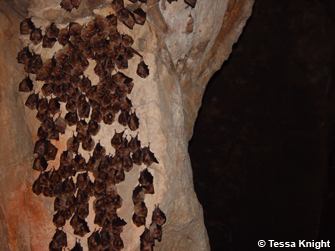
Horseshoe bats

There are two horseshoe bat species within the British Isles; the greater horseshoe Rhinolophus ferrumequinum and the lesser horseshoe Rhinolophus hipposideros. Both species are considered by The Bat Conservation Trust to be endangered. The greater horseshoe is restricted to south Wales and south-west England, whilst the range of the lesser horseshoe also includes north Wales and western Ireland. The two species have undergone a significant contraction in their range within the last century, and are now restricted to less than 20 greater horseshoe and 230 lesser horseshoe maternity (summer breeding) roosts in south-west England and Wales.
The British and Irish populations of lesser horseshoe bat are significant numerically in a European context and now form one of the European strongholds. The current British population of greater horseshoes is estimated at 4000–6000 individuals, and that of lesser horseshoes is estimated at 14 000. The Mendip Hills support significant populations of both species, with two areas being set up as Special Areas of Conservation.
Both species mate in September or October, but females do not give birth until June or July of the following year. Horseshoe bats normally have only one offspring per year, and weaning takes up to seven weeks. From ringing studies it has been found that greater horseshoe bats can live for up to 30 years. Similar long-term studies have not been undertaken with lesser horseshoes though it is thought that they can live for up to 15 years.
When roosting both species are free-hanging with their wings folded around their body. The greater horseshoe is one of the largest of the 16 British resident species of bat and when roosting is approximately the same size as a small pear. The lesser horseshoe is one of the smallest UK bat species and is of a similar size to a small plum. The greater horseshoe hunts large prey, for example, cockchafers, dung beetles, noctuid moths and crane-flies, whilst the lesser horseshoe will feed on midges, small moths and caddis flies. The increased use of pesticides by farmers in recent decades has led to a decrease in the availability of larger beetles over large areas of the countryside.

Both greater and lesser horseshoes were originally cave dwellers. However the majority of maternity colonies are now found in the roofs of large rural buildings, the bats selecting sites with large entrance holes and access to an open roof space. Typical sites include barns and rural farmhouses. In the winter months both species hibernate in caves, disused mines, cellars and tunnels. The widespread dispersed farm settlements on the higher ground of Mendip, in particular near Cheddar, offer a large number of suitable summer roosting sites for both species. Taken together with the high numbers of cave systems and mines across the area, this offers optimum roosting opportunities at all times of the year for the two species.
- Home
- Overview maps
- Locality
areas
- Cheddar Gorge
- Charterhouse
- Blackdown
- Burrington Combe
- Shipham & Rowberrow
- Crook Peak & Axbridge
- Banwell to Churchill
- Priddy
- Harptree & Smitham Hill
- Draycott & Westbury-sub-Mendip
- Wookey Hole & Ebbor Gorge
- Wells
- Great Elm & Vallis Vale
- Mells & the Wadbury Valley
- The Vobster area
- The Whatley area
- Torr Works & Asham Wood
- Beacon Hill
- Stoke St Michael & Oakhill
- Holwell & Nunney
- Shepton Mallet & Maesbury
- Gurney Slade & Emborough
- The Nettlebridge valley
- Geology
- Minerals and mines
- Quarrying
- Caves and karst
- Biodiversity
- Detailed site information
- Acknowledgements
- External links
- Search
- Site map